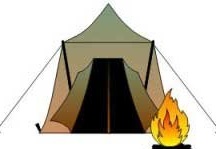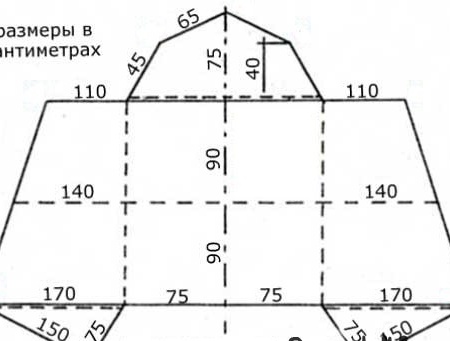
It's always nice to do something do it yourself. Summer has come and with it the time for vacations. Flocks of tourists stretched to the warm lands. Not everyone buys tours that are all inclusive. Many go on vacation to the savages, or in places with an equipped place for camping. In this case, you can’t do without a tent. But where to get it?
You can buy in the store. Even in this case, rest will cost you much cheaper than buying a ready-made tour in a travel company. A good tent should be reliable, withstand the loads of a hike. The frame should be durable, ideally made of metal. The space inside the tent should be sufficient to accommodate. For example, if the tent has 4 places, then it can comfortably accommodate 2 people. The size of the tent in length should, again, be larger than your height (if you are 185 cm tall, then the tent should be 210 cm). The material of the tent should reliably prevent the penetration of rain moisture inside and, at the same time, let air through. The weight and dimensions of the tent should be small. In a campaign, every kilogram counted and a couple of extra kg of tent weight can be a problem.
In modern stores, a large selection. There are many different models and configuration options. But, nevertheless, it can be very difficult to find the very option that will suit you all 100. What to do? Our answer is to make a tent ourselves. There are many options for making tents, from simple cloak tents to large camping tents. We, considering all of the above, will stop at a simple tent.
Sewing a tent will require lightweight and durable material. Tarpaulin or tent fabric will do.
The example shows the dimensions of the tent, which can be adjusted depending on your proportions. The inclined shape is due to the fact that the wind will blow around the tent. And the likelihood that it will be carried at night at rest will decrease.
The riser in such a tent will be only in front. The back wall will be stretched. If it is possible to install a tent between two trees, then the need for a riser will generally disappear, if you can stretch the front and back of the tent to the trees.
It is advisable to form a riser in the form of the letter L. So you will avoid injuries by crawling into the tent at night. And carrying luggage will be more convenient.

The figure shows a diagram of the cut of the tent. It details the proportions to be followed. Attach stretch marks in the form of a nylon rope in the center of the front and rear of the tent. Rings for stakes - on the four edges of the tent.
It is necessary to secure the tent from water penetration. The following describes how to do this.
Put 4 kg of soap, 25 grams of soda, 450 grams of grated rosin on 4 liters of heated water. Soak a tent in this mixture for a couple of hours. After take out and dry.
In another way, you can soak the tent with a solution (50 percent) of soap. After shift in a solution of vitriol (20%). Wait a few minutes, remove and dry. Wear protective gloves. After the operations are done, the tent acquires a camouflage green color, which will hide it in the forest from prying eyes.
Other methods of hardening the tent are associated with large losses of time, and we will not consider them here. You can simply buy a plastic film and cover it with a tent, fastening it with clothespins or fastening it with ropes to an external awning.
The tent is almost ready. It is necessary to strengthen the tent tent in places of greatest tension. Namely, in places of fastening of tension tapes, zippers at the entrance. This is easy to do by skipping a second layer of tent material at the seam.
The bottom of the tent, on which the karemat and the bed will lie, should be water-repellent. We make it from durable polyethylene. We cut the required amount of material along the contour of the tent and sew it with strong threads with the main tent of the tent.
If desired, you can make ventilation windows for air circulation inside the tent. Otherwise, the air inside will be heavy at night, and it will be difficult to breathe. On the sides of the tent we make two symmetrical cuts, which then need to be stitched with threads along the contour so that the tent fabric does not disperse. At the time of assembly of the tent, we break off two branches of the nearest tree of 10-15 centimeters and install them in these holes. Thus, two ventilation windows are formed through which fresh air will fill your tent.
